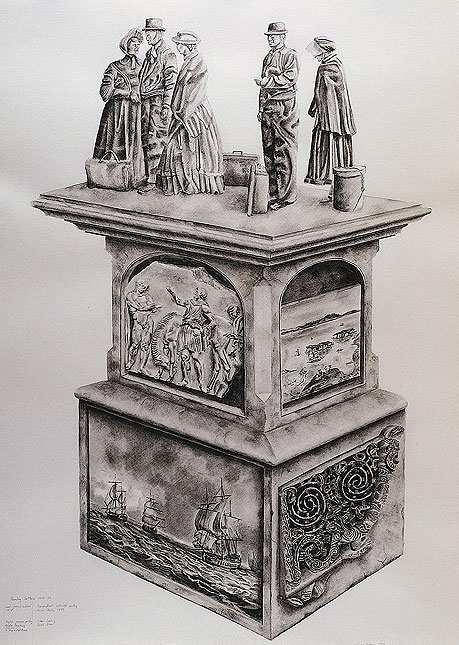DUNNING, William;
Founding Settlers 1840–50
1994
Charcoal and acrylic on paper
1035 x 740mm

This unusual work by Ōtautahi painter William Dunning was part of a 1994 exhibition titled Time Branching Time at McLeavey Gallery, Te Whanganui-a-Tara. The artist took thirteen points in New Zealand’s post-European history and treated them as if they were memorials. The statue-like figures in each work are mounted on plinths, the façades of which are sketched with historical subjects or motifs. The thirteenth painting was called Waitangi Day, and the statues represented the people who walked with the Queen on to the Treaty House grounds on 6 February 1990, the 150th anniversary of the signing of the Treaty of Waitangi.
In Founding Settlers 1840–50, the façades illustrate various visual elements that the newly arrived settlers might well have had as part of their visual baggage: a classical Greek sculptural relief of the type plundered from temples in Greece (during the 19th century, these were thought to represent the pinnacle of Western artistic achievement and widely collected); the carved prow of a waka, recalling the manner in which the settlers’ predecessors, Aotearoa’s indigenous Māori inhabitants, arrived from northern Polynesia; a topographical watercolour by Charles Heaphy, typical of the panoramas produced by artists in the era before aerial photography; and an English marine painting by Charles Brooking called A Ship in a Light Breeze.
Inscriptions
Founding Settlers 1840–50 / Greek classical sculptural relief / English marine painting / Charles Brooking / 1723–59 / A Ship in a light Breeze ; Topographical watercolour painting / Charles Heaphy 1843 / Maori carving, / canoe prow. [l.l.] William Dunning 1994 [l.r.]Exhibition History
Time Branching Time, McLeavey Gallery, Te Whanganui-a-Tara, 26 April to 21 May 1994
Provenance
1994–
Fletcher Trust Collection, purchased from McLeavey Gallery, Te Whanganui-a-Tara, July 1994
